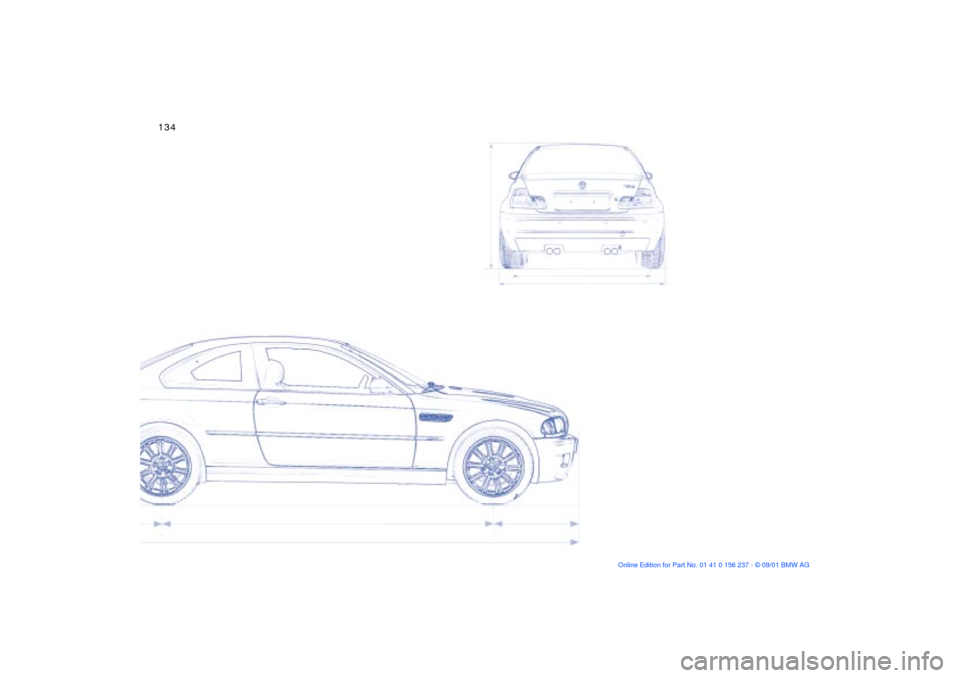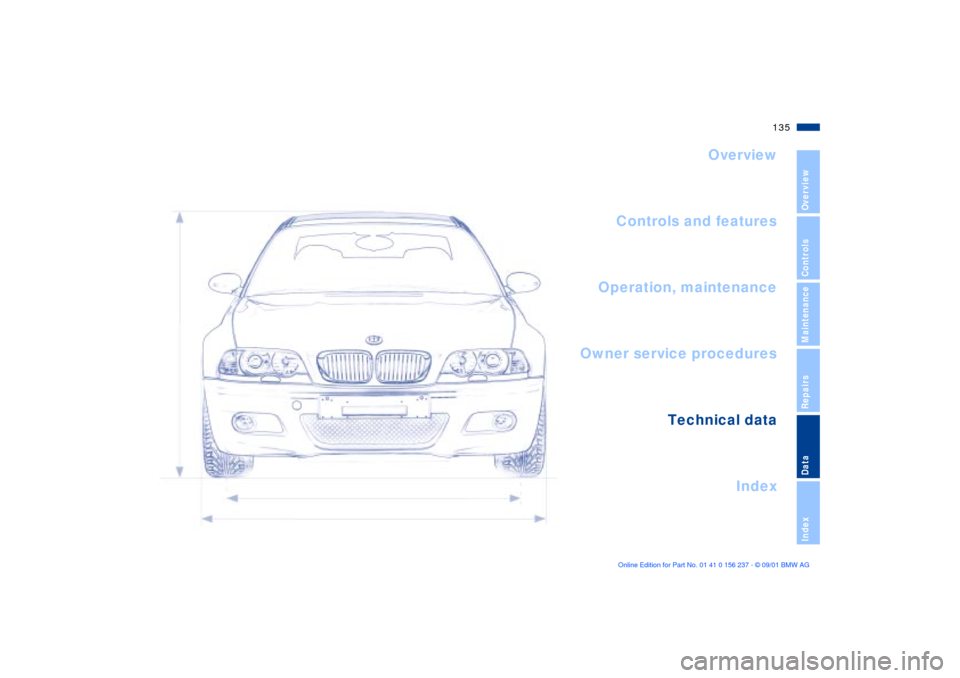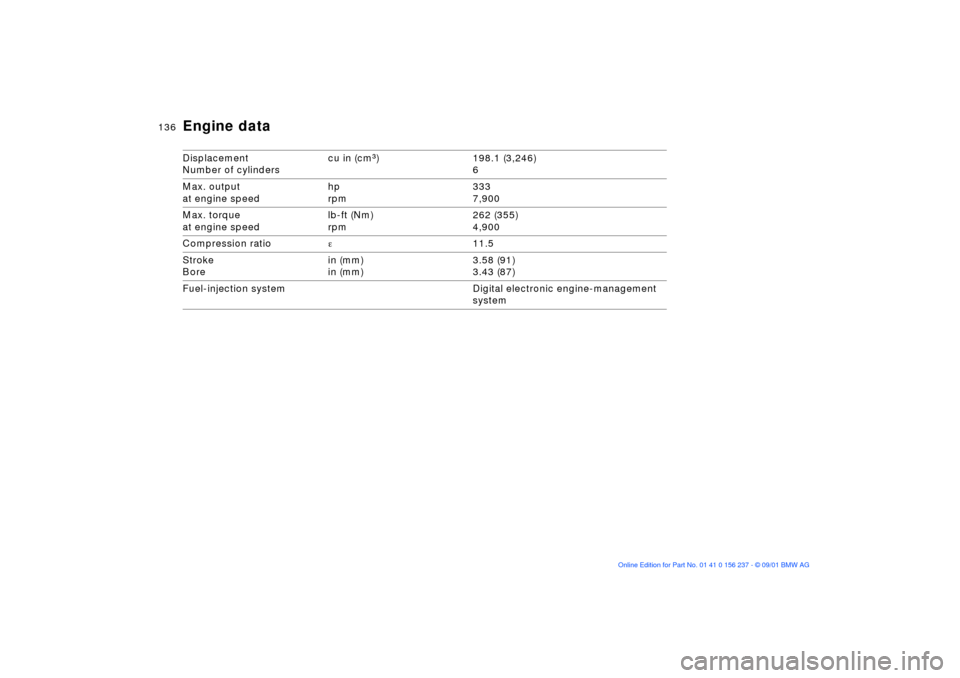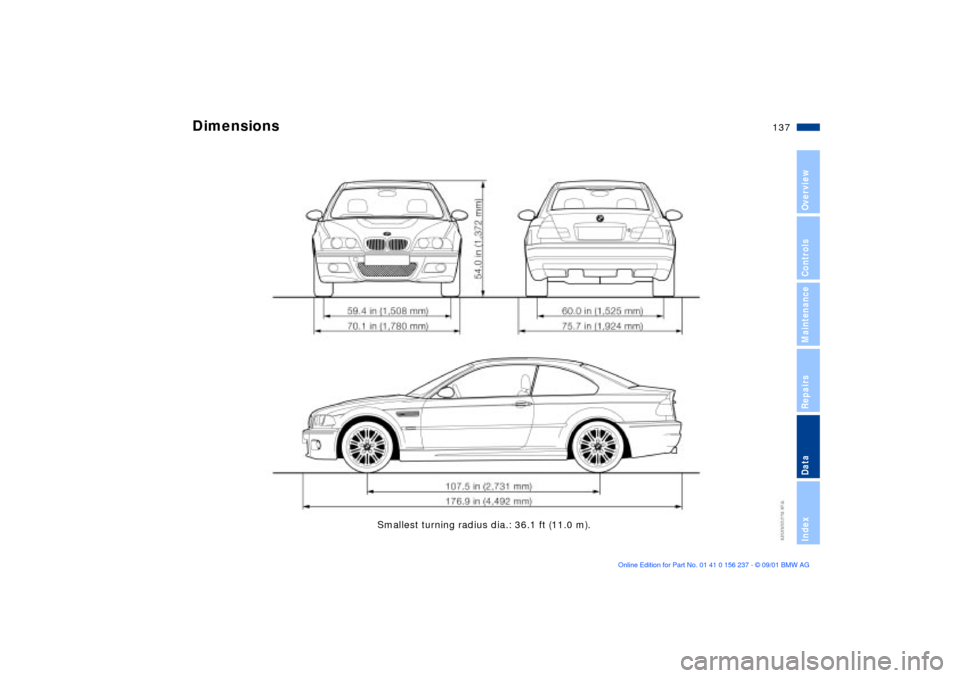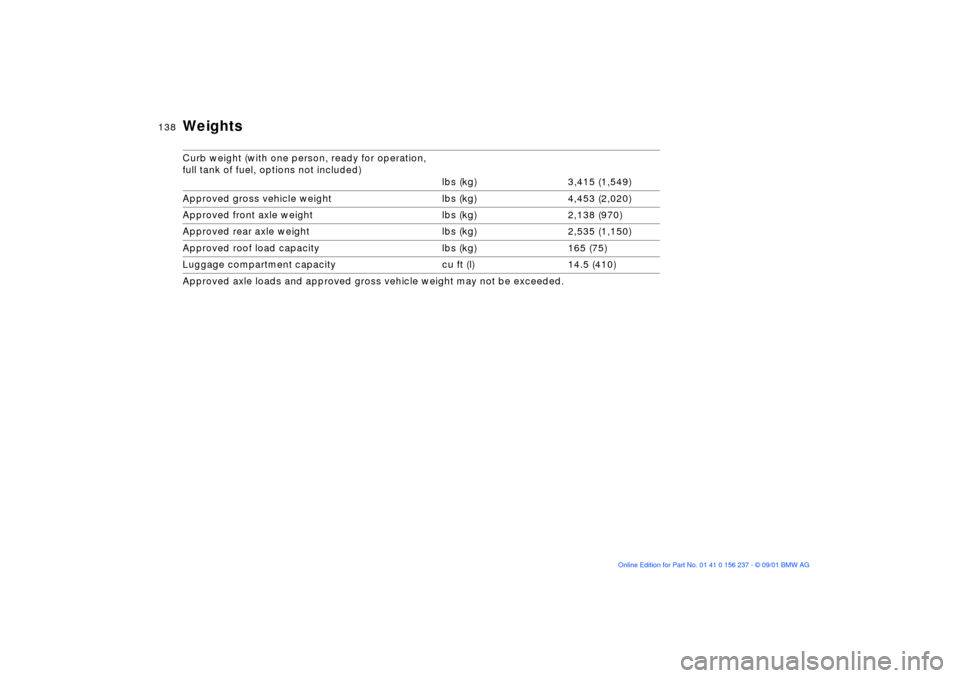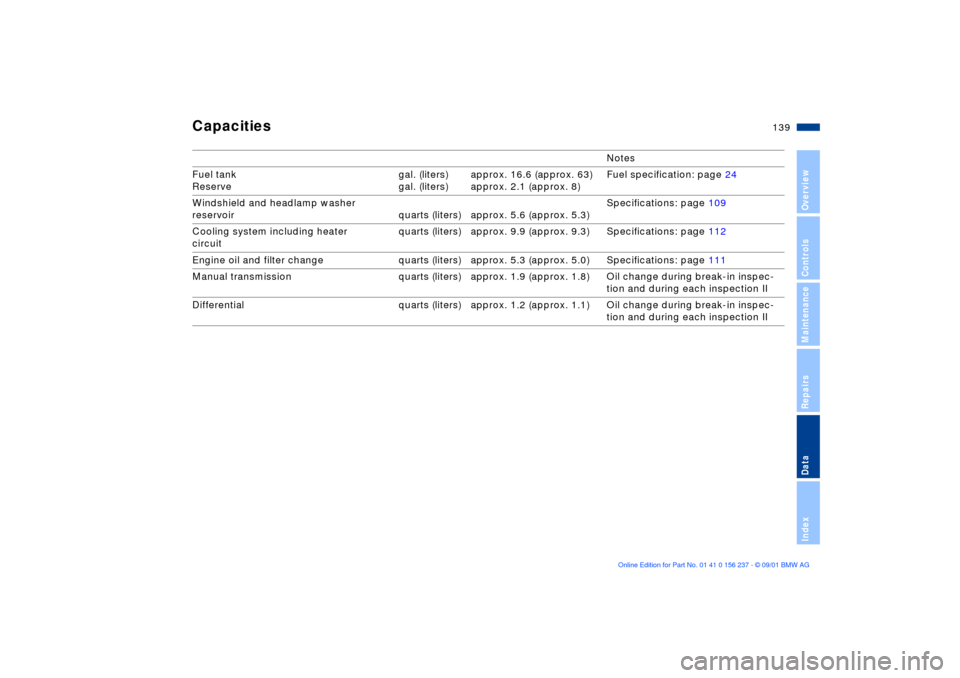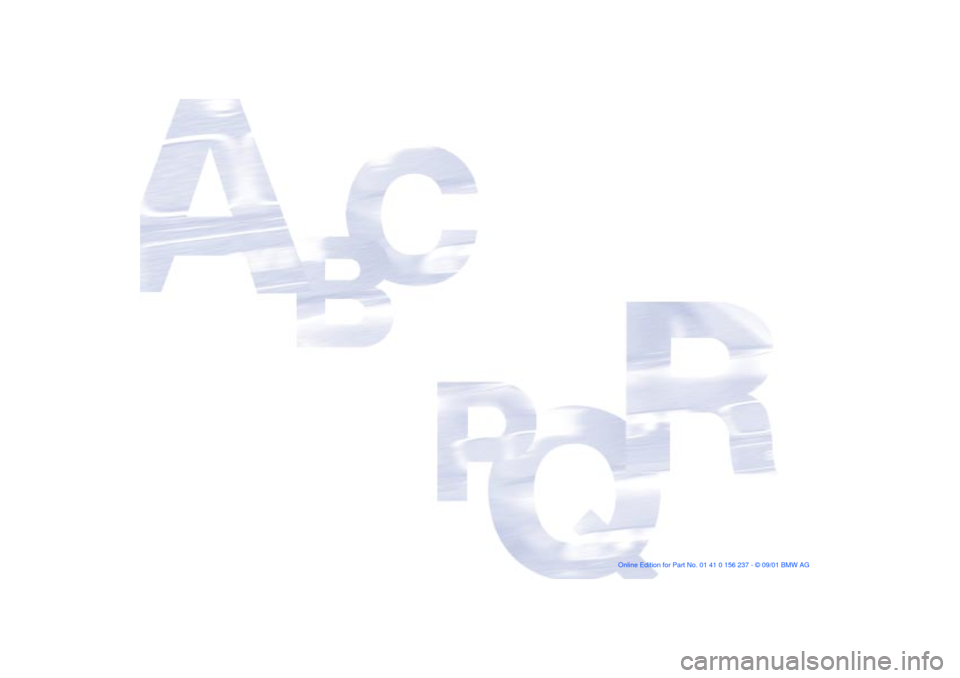BMW M3 COUPE 2002 E46 Owner's Manual
M3 COUPE 2002 E46
BMW
BMW
https://www.carmanualsonline.info/img/1/2836/w960_2836-0.png
BMW M3 COUPE 2002 E46 Owner's Manual
Trending: tire size, low oil pressure, center console, child lock, turn signal bulb, window, engine overheat
Page 131 of 151
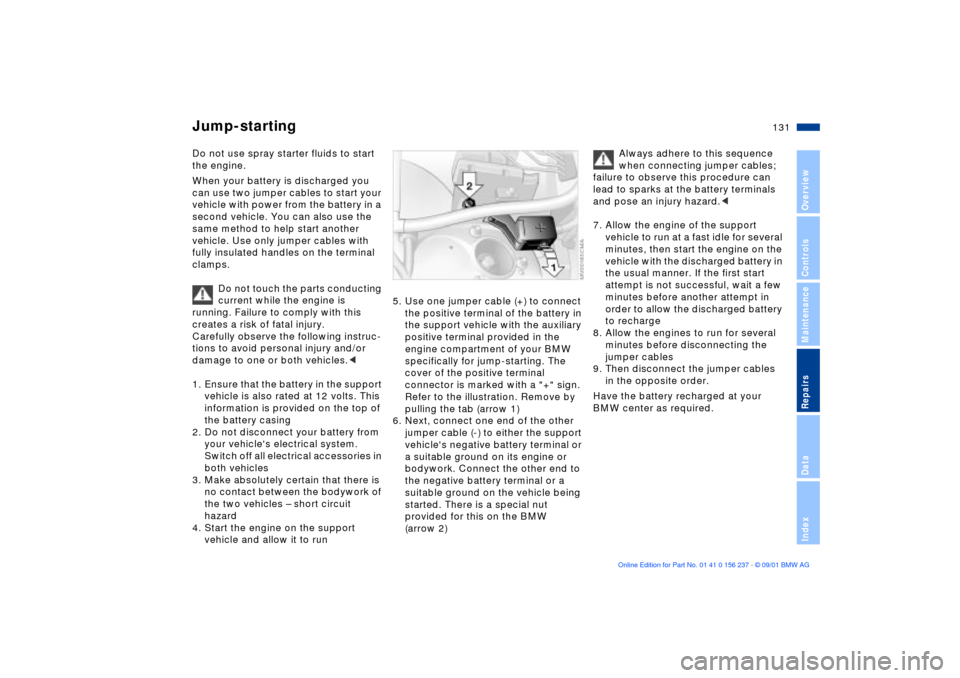
131n
OverviewControlsMaintenanceRepairsDataIndex
Do not use spray starter fluids to start
the engine.
When your battery is discharged you
can use two jumper cables to start your
vehicle with power from the battery in a
second vehicle. You can also use the
same method to help start another
vehicle. Use only jumper cables with
fully insulated handles on the terminal
clamps.
Do not touch the parts conducting
current while the engine is
running. Failure to comply with this
creates a risk of fatal injury.
Carefully observe the following instruc-
tions to avoid personal injury and/or
damage to one or both vehicles.<
1. Ensure that the battery in the support
vehicle is also rated at 12 volts. This
information is provided on the top of
the battery casing
2. Do not disconnect your battery from
your vehicle's electrical system.
Switch off all electrical accessories in
both vehicles
3. Make absolutely certain that there is
no contact between the bodywork of
the two vehicles Ð short circuit
hazard
4. Start the engine on the support
vehicle and allow it to run
5. Use one jumper cable (+) to connect
the positive terminal of the battery in
the support vehicle with the auxiliary
positive terminal provided in the
engine compartment of your BMW
specifically for jump-starting. The
cover of the positive terminal
connector is marked with a "+" sign.
Refer to the illustration. Remove by
pulling the tab (arrow 1)
6. Next, connect one end of the other
jumper cable (-) to either the support
vehicle's negative battery terminal or
a suitable ground on its engine or
bodywork. Connect the other end to
the negative battery terminal or a
suitable ground on the vehicle being
started. There is a special nut
provided for this on the BMW
(arrow 2)
Always adhere to this sequence
when connecting jumper cables;
failure to observe this procedure can
lead to sparks at the battery terminals
and pose an injury hazard.<
7. Allow the engine of the support
vehicle to run at a fast idle for several
minutes, then start the engine on the
vehicle with the discharged battery in
the usual manner. If the first start
attempt is not successful, wait a few
minutes before another attempt in
order to allow the discharged battery
to recharge
8. Allow the engines to run for several
minutes before disconnecting the
jumper cables
9. Then disconnect the jumper cables
in the opposite order.
Have the battery recharged at your
BMW center as required.
Jump-starting
Page 132 of 151
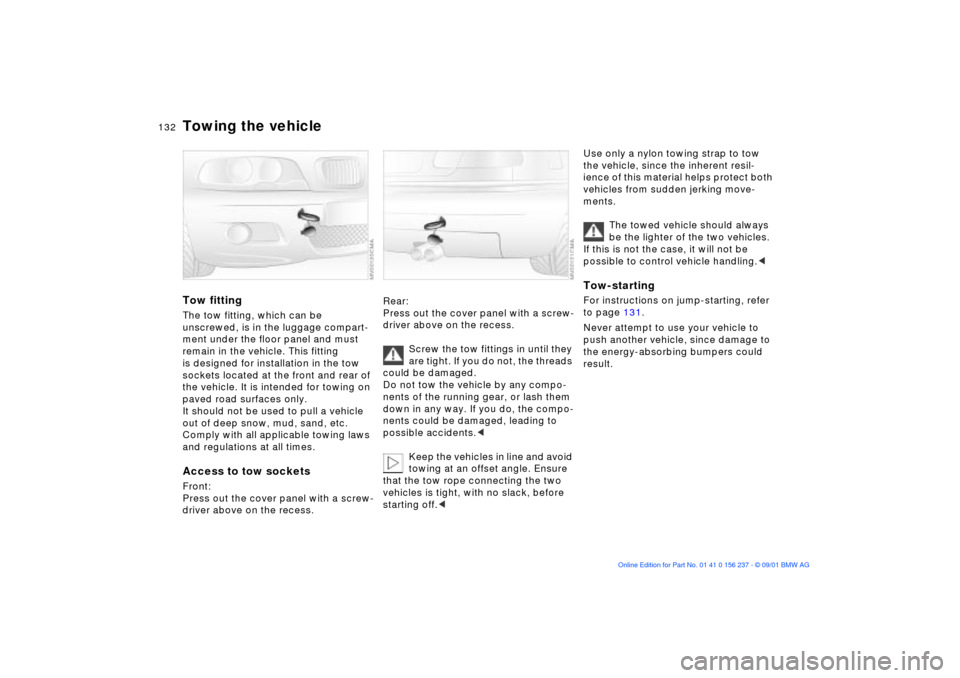
132n
Towing the vehicleTow fittingThe tow fitting, which can be
unscrewed, is in the luggage compart-
ment under the floor panel and must
remain in the vehicle. This fitting
is designed for installation in the tow
sockets located at the front and rear of
the vehicle. It is intended for towing on
paved road surfaces only.
It should not be used to pull a vehicle
out of deep snow, mud, sand, etc.
Comply with all applicable towing laws
and regulations at all times.Access to tow socketsFront:
Press out the cover panel with a screw-
driver above on the recess.
Rear:
Press out the cover panel with a screw-
driver above on the recess.
Screw the tow fittings in until they
are tight. If you do not, the threads
could be damaged.
Do not tow the vehicle by any compo-
nents of the running gear, or lash them
down in any way. If you do, the compo-
nents could be damaged, leading to
possible accidents.<
Keep the vehicles in line and avoid
towing at an offset angle. Ensure
that the tow rope connecting the two
vehicles is tight, with no slack, before
starting off.<
Use only a nylon towing strap to tow
the vehicle, since the inherent resil-
ience of this material helps protect both
vehicles from sudden jerking move-
ments.
The towed vehicle should always
be the lighter of the two vehicles.
If this is not the case, it will not be
possible to control vehicle handling.
to page 131.
Never attempt to use your vehicle to
push another vehicle, since damage to
the energy-absorbing bumpers could
result.
Page 133 of 151
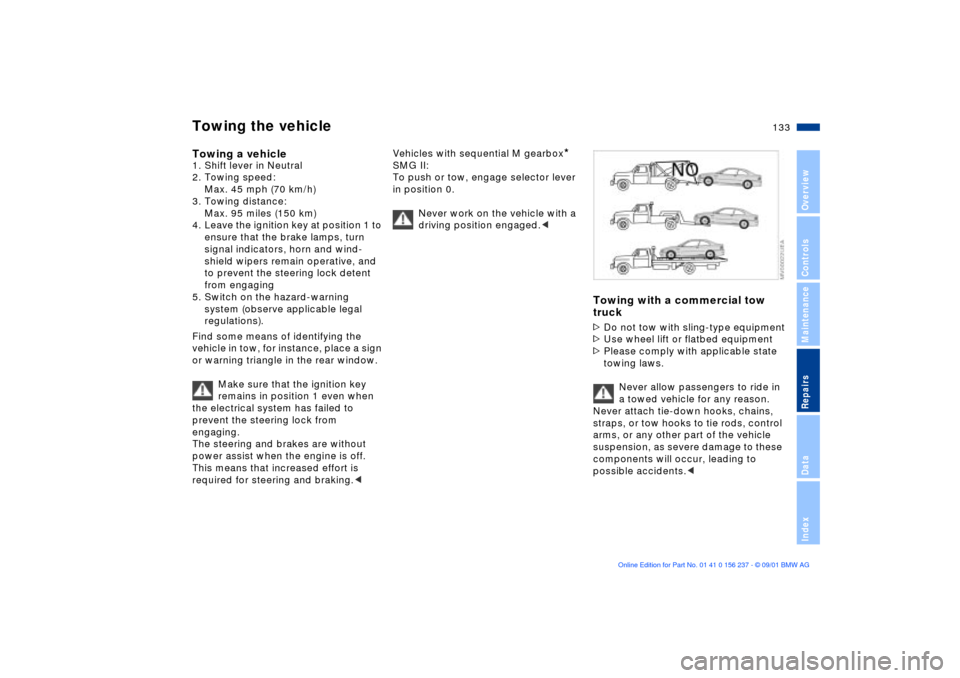
133n
OverviewControlsMaintenanceRepairsDataIndex
Towing the vehicleTowing a vehicle1. Shift lever in Neutral
2. Towing speed:
Max. 45 mph (70 km/h)
3. Towing distance:
Max. 95 miles (150 km)
4. Leave the ignition key at position 1 to
ensure that the brake lamps, turn
signal indicators, horn and wind-
shield wipers remain operative, and
to prevent the steering lock detent
from engaging
5. Switch on the hazard-warning
system (observe applicable legal
regulations).
Find some means of identifying the
vehicle in tow, for instance, place a sign
or warning triangle in the rear window.
Make sure that the ignition key
remains in position 1 even when
the electrical system has failed to
prevent the steering lock from
engaging.
The steering and brakes are without
power assist when the engine is off.
This means that increased effort is
required for steering and braking.c
Vehicles with sequential M gearbox
*
SMG II:
To push or tow, engage selector lever
in position 0.
Never work on the vehicle with a
driving position engaged.c
Towing with a commercial tow
truck>Do not tow with sling-type equipment
>Use wheel lift or flatbed equipment
>Please comply with applicable state
towing laws.
Never allow passengers to ride in
a towed vehicle for any reason.
Never attach tie-down hooks, chains,
straps, or tow hooks to tie rods, control
arms, or any other part of the vehicle
suspension, as severe damage to these
components will occur, leading to
possible accidents.c
Page 134 of 151
Page 135 of 151
135n
OverviewControlsMaintenanceRepairsDataIndex
Overview
Controls and features
Operation, maintenance
Owner service procedures
Index Technical data
Index
Page 136 of 151
136n
Displacement
Number of cylinders cu in (cmm) 198.1 (3,246)
6
Max. output
at engine speed hp
rpm333
7,900
Max. torque
at engine speedlb-ft (Nm)
rpm262 (355)
4,900
Compression ratioe
11.5
Stroke
Borein (mm)
in (mm)3.58 (91)
3.43 (87)
Fuel-injection system Digital electronic engine-management
system
Engine data
Page 137 of 151
137n
OverviewControlsMaintenanceRepairsDataIndex
Smallest turning radius dia.: 36.1 ft (11.0 m).
Dimensions
Page 138 of 151
138n
Weights Curb weight (with one person, ready for operation,
full tank of fuel, options not included)
lbs (kg) 3,415 (1,549)
Approved gross vehicle weight lbs (kg) 4,453 (2,020)
Approved front axle weight lbs (kg) 2,138 (970)
Approved rear axle weight lbs (kg) 2,535 (1,150)
Approved roof load capacity lbs (kg) 165 (75)
Luggage compartment capacity cu ft (l) 14.5 (410)
Approved axle loads and approved gross vehicle weight may not be exceeded.
Page 139 of 151
139n
OverviewControlsMaintenanceRepairsDataIndex
Capacities
Notes
Fuel tank
Reserve gal. (liters)
gal. (liters)approx. 16.6 (approx. 63)
approx. 2.1 (approx. 8)Fuel specification: page 24
Windshield and headlamp washer
reservoir quarts (liters) approx. 5.6 (approx. 5.3)Specifications: page 109
Cooling system including heater
circuitquarts (liters) approx. 9.9 (approx. 9.3) Specifications: page 112
Engine oil and filter change quarts (liters) approx. 5.3 (approx. 5.0) Specifications: page 111
Manual transmission quarts (liters) approx. 1.9 (approx. 1.8) Oil change during break-in inspec-
tion and during each inspection II
Differential quarts (liters) approx. 1.2 (approx. 1.1) Oil change during break-in inspec-
tion and during each inspection II
Page 140 of 151
Trending: transmission oil, door lock, brake fluid, dimensions, washer fluid, service schedule, steering wheel adjustment



